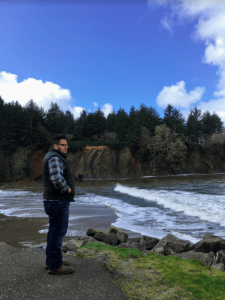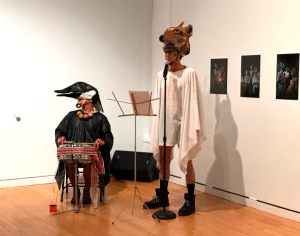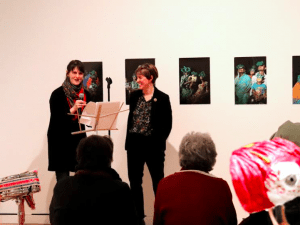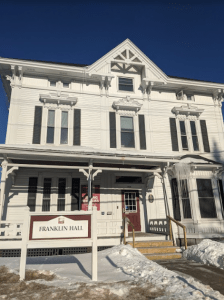Feb 29, 2020 | Bite Me Beaver, Feature |
Dear Bite,
My cat keeps waking me up by attacking my feet in the morning. Unfortunately, my immediate reaction is to kick due to being startled, knocking my poor cat off the bed. How do I stop this cruel instinctual vice?
-Toe-Smitten Kitten
Dear Toe-Smitten,
Look dude, my first instinct is to kick anyone who’s got a thing for feet too. Which clearly your cat does. The answer here is to kink-shame your cat into repressing its urge to go after your feet. When a guy at The Roost grabbed my foot out of nowhere, I threatened to skin him alive and that seemed to do the trick.
____________________________________________________________
Dear Bite,
So during that last fire alarm debacle in FAB, one of the alarms went off while my boyfriend and I were mid-action. And I guess my question is, would it be bad to finish before we leave if that ever happens again?
-Coming and Going
Dear Coming and Going,
Are you trying to say that you engage in the pre-marital frickle-frackle on my morally pure campus? You heathens. Finish or don’t, that’s up to you, but whatever you decide might mean that more than just the building is burning.
____________________________________________________________
Hey you…
Bite’s going to a farm upstate at the end of this semester. . . Yeah that’s right, this Bite is getting kicked to the curb (graduating) and now we need a new one.
Do you have a problem containing your scathing sarcasm? Do you have an uncanny to make any situation so much worse if only for the sake of being the mistress or master of chaos? Do you have just enough undue arrogance to think you can take over this terrible advice column and steer campus readers wrong a few times a semester? If so, you should come to a Flyer staff meeting in Roberts 010 on Monday’s at 12:15 p.m. or email umfdearbeaver@gmail.com to show your interest. Please for the love of everything good in this world, try it out. We’re vaguely (really) desperate.
Feb 29, 2020 | Feature |
It is tax season and that means that college students who file are most likely getting refunds.
If you worked a lot in 2019 the chances are your refund is large. If you’re not behind on bills or desperately need to spend the money, this is a good chance to get ahead on your savings and build an emergency fund.
There are also many ways you could invest this money rather than using it for quick purchases that provide momentary satisfaction. Saving your money to use on textbooks next fall, using it as grocery money for the semester, paying rent, or investing it into your long term savings account are all really good ways for spending your refund wisely.
Making conscientious purchases such as those will benefit you in the long run, rather than using it to go out to dinner, to buy your 7th pair of Vans or a new sweatshirt.
Be smart with your refund and be sure to file your taxes with us by setting up an appointment with a peer coach by contacting caleb.grover@maine.edu.

Feb 29, 2020 | Exclusive |
Andrea Swiedom Staff Reporter
When sophomore Antonio Cortez, 36, brought his wife to his parent’s house for the first time, she thought his brothers were initiating a spontaneous sleepover after dinner as they pulled out pillows and blankets. Cortez had to explain that was just their bed.
“I grew up sleeping on a living room floor,” Cortez said. There with him were his four brothers in a one bedroom apartment in Anaheim, CA.
In hopes of providing a better future for their children, Cortez’s parents crossed the border from Southern Mexico. “They wanted their American-born children to go to college,” Cortez said.
In 2002, Cortez enrolled in a vocational program in Orange County, CA where he earned an associates degree in mechanical engineering while working full-time as a cement mason. But he always had military service in mind as a back-up plan. By 2004, it became his best option. “Eventually I just got to the point where, we were struggling, we needed health care. It was really the lure of the financial assistance.”
Cortez’s wife was struggling with health problems and the hospital bills were continuously draining their savings. “I made up to 30 bucks an hour, but it seemed like every time we visited the hospital it was a couple thousand dollars,” Cortez said.

Antonio Cortez (Photo Courtesy of Antonio Cortez)
To cover the costs of education and healthcare, Cortez worked 60 hour weeks and saw the physical effects that decades of masonry had on those around him. “I saw a guy doing it for 20 years and he was calloused and sunburnt,” Cortez said, scrunching his fingers. “I thought, I don’t know if I want to do this for the rest of my life.”
Cortez’s first step towards military service was complete happenstance. He was running errands with his father one afternoon when their car got a flat tire. While waiting for roadside assistance, Cortez found himself staring into the window of a recruitment office. A recruiter came outside and convinced Cortez to apply and take the Armed Services Vocational Aptitude Battery (ASVAB) test right then and there.
Within a week of the test, Cortez, determined to pursue the most intense level of training, jumped at a last minute opening for a Ranger Airborne spot and left for Army Ranger school.
“They do SERE training which is survival, evasion, resistance and escape and you go through psychological warfare,” he said. “They lock you in a dog kennel, spray you with a hose. . .it’s just seeing how far you can go before you break. You want to be the guy that doesn’t break, but eventually you do.”
Cortez was deployed in Baghdad, Iraq where he manned an old yacht house-turned army base with 12 other American soldiers and 25 Iraqi police. “It had marble floors, a marble staircase and it was all shot up,” he said. “The water was murky brown. It was half mercury and if you ate the fish in the river, you would get jaundice.”
While in Baghdad, he sustained a severe leg injury from a grenade attack while riding in a truck back to the base. He was wounded by what he described as a molten needle that penetrated the three inches of steel and electrical system of the truck before shattering his knee.
“I couldn’t bend my leg; I thought it was gone. I couldn’t feel most of the left side of my body,” Cortez said while gingerly rubbing the side of his left leg.
After eight years of military service, getting shot in the back and jumping out of airplanes, this was ultimately the injury that led to his medical discharge.
“Most of my military career was like, ‘Hey, you’re alive now. Just get through it to get back to hot dogs and Budweiser,’” Cortez said with a straight face.

St MèreÉglise Drop Zone, Fort Bragg, N.C. (Photo Courtesy of Antonio Cortez)
After his recovery, he spent 30 days in a military out-processing program primarily geared towards retirees and left him with little information as to what benefits and services were available to him as an injured veteran coming straight out of combat.
The lack of information influenced his desire to volunteer with veteran programs to inform others about resources available to them as they transition to civilian life.
“I have spent most of my time since the military trying to figure out how to make up for some crummy things I had to do, not necessarily by choice,” Cortez said.
At UMF, he’s studying rehab management with the ultimate aim to work with veterans dealing with post-combat issues.
Cortez landed in Farmington by happenstance just as he ended up in the military. After leaving the army in 2012, he spent several years soul searching. He worked various jobs in the automotive industry and as a millwright designing and welding custom kitchen suites. Once again, he found himself overworked and burnt out.
With some pension funds and the desire to travel, Cortez, his wife and 12 year old son hit the road in an RV traversing the country three times before ending up at a campsite in Canon, Maine. It only took three months at the seasonal site for the family to realize that Maine was home, and Cortez’s son was ready to attend a public school.
“We love small town life. We just like rural because people want to help you just because they want to help,” Cortez said. “People here are just generally great, and it’s beautiful here.”
He expressed a great appreciation for the UMF campus and the relationships he’s formed with professors due to the open atmosphere and small class sizes.
“Farmington is UMF, and UMF is Farmington. And it’s cool that the public is allowed to use the facilities and the gym,” Cortez said. “It’s really a community.”

Feb 28, 2020 | News |
Taylor Burke, Contributing Writer
The VOYAGER: Migrational Narratives exhibit introduces a conversation on migration to the UMF community through various mediums and perspectives. The exhibit, which is free to the public, opened from Jan. 30 to March 6.
Olivia Donaldson and Ann Bartges, curators of the exhibit, recently opened the gallery on a night that included live performances and virtual reality experiences. The exhibit features paintings, collages, photographs, textiles, sculptures, a poem and digital media pieces that viewers can watch and listen to. Each piece explores what it means to migrate and highlights experiences and perspectives on migration.
Donaldson, a French professor, has been researching migration and teaches global studies. She is passionate about migration and interested in the arts. Bartges is the director of the Emery Community Arts Center and a professor of visual arts.
Donaldson and Bartges were friends prior to the project which aided their collaboration. They began conversing about migration over a poem that became part of the exhibit. “In some ways, the poet launched the conversation between Olivia and I a long time ago,” Bartges said, “the poem kind of started the whole idea of the exhibition.” Bartges proposed the idea of the exhibit to Donaldson in her efforts to find ways that Emery could serve the rest of the campus, not just the art department.
The whole project took about a year to complete. “I don’t know if either of us really mapped that out when we started this,” Bartges said laughing with Donaldson. With Bartges’ background in art and Donaldson’s vision for interdisciplinary work, the two complemented each other in the curation process.

Arturo Herrera (left) and David Sanders (right) perform at the opening night for the VOYAGER exhibit. Photo Courtesy of Ann Bartges.
Donaldson and Bartges put out a call for submissions and were presented with a strong pool of pieces. “The works by artists who had experienced migration first hand had so much more depth,” said Bartges. “Those works just tended to have more layers,” she said.
Bartges and Donaldson’s decisions were influenced by their vision for the exhibit and tone they wanted to set. “We really didn’t want the show to become a binary conversation about whether migration is good or bad,” Donaldson said. “We wanted the show to be about connections.”
Bartges found Nayda Cuevas’ piece, “Adios: Puerto Ricans Always in Migration” to capture the tone they wanted for the exhibit. “We wanted to show this really human part of the migration experience,” she said.
This exhibit provides another perspective to understanding migration and its many facets. “We all engage with [migration] in newspaper headlines and in political language,” Bartges said. “But then there’s this other opportunity to engage in these issues through stories and narratives and experiences.”
One of the mediums, included only on opening night, was a virtual reality film called “A Shared Space: Lewiston,” created by documentary filmmaker Daniel Quintanilla and collaborators Shuab Mahat and Hilowle Aden. The film chronicles Mahat and Aden, two friends, who grew up in the Dadaab Refugee Camp in Eastern Kenya and currently live in Lewiston. “It looks at the challenges they each face in raising families in Maine during a time of rising nationalism, closed borders and travel bans,” Quintanilla said in an email.
The virtual reality experience allows viewers to immerse themselves in the content in ways other forms don’t allow for. “[A Shared Space: Lewiston] came out of a need to create content that could help others see and imagine the lives of others,” Quintanilla said.“We saw 360-degree cameras and headsets as a way to create virtual experiences in which we could invite viewers to enter spaces they might not be able to enter on their own.”
The creators of the film wanted to call attention to Maine’s connection with migration and the issues that surround it.“It’s too easy to be passive and think that families separated by ICE, borders, or policies is happening elsewhere,” Quintanilla said. “One of our goals is to highlight Maine’s relationship to global migration.”
This piece, like all of the others in the exhibit, is a way of storytelling and communicating human experiences. “I hope viewers are not only moved by the stories presented,” Quintanilla said in an email. “But can translate that empathy into action of some kind.”
Two of the pieces in the exhibit were created by creative writing professor, Éireann Lorsung. Her first work, “Completely out of Water,” is a collage piece from a series of 15 that she made during her time in Belgium.
Lorsung used this piece to play with English idioms while also channeling her own experience of being foreign. “What happens when you make an idiom literal?” she said. “What’s literally happening is very uncomfortable.” Although the literal meanings of idioms can cause discomfort, the piece was also supposed to evoke some humor due to the differences between the literal and metaphorical meanings of idioms.

Curators Ann Bartges and Olivia Donaldson speak at the opening night of the VOYAGER exhibit. Photo Courtesy of Ann Bartges.
Lorsung’s second piece, “Royaume de lumière x 144,” is part of a series of 144 small paintings that document the land that she lived on and had to leave. There is also a sound bit that goes along with the piece and plays a recording of the sounds from her garden.
When Lorsung left Belgium she lost her sheep and garden, among other things. “There’s no clear way to live through that,” Lorgsung said. “Art is a way that I’m trying to understand all that stuff.”
All the objects in the paintings are drawn from memory in an effort to reclaim what can’t be reclaimed. “Basically all the work I do is really thinking about having been an immigrant and what it meant to leave,” she said.
As an immigrant herself, Lorsung has noticed that migration is generally demeaning despite it being a natural and historical occurrence. “It’s borders and boundaries that are the new thing,” she said. “Human migration is not a new thing.”
Arturo Herrera, who is based in the Detroit area, was the creator of “The National Bird” piece displayed at the exhibit. “The National Bird is an experimental performance series highlighting several migratory animal disguises,” Herrera said in an email. “It builds on the premise that wild creatures can legally cross territorial boundaries anytime and anywhere without checkpoints.”
“The National Bird” gave and still gives Herrera the opportunity to create work that tells his personal story while not being directly about him. The piece is not finished and continues to evolve and grow, much like the subject of migration. “The work provides a different perspective on issues of relevant concern like immigration,” he said.
Herrera attended the opening night of the show and performed using two characters from his series. “[M]y impression was great of the show, as well as how every work in the gallery was speaking with each other,” he said in an email.

Feb 28, 2020 | Feature |
Andrea Swiedom Staff Reporter
Title IX is a federal law that protects individuals at federally-funded institutions like UMF from discrimination including sexual harassment and assault as these impede on a person’s participation in education. When students experience sexual harassment and/or assault on campus, they have the option of reporting their case to mandated reporters who include the majority of faculty, staff, certain students employees, volunteers and peer advocates.
“The only people out of this list who are not mandated reporters are the mental health counselors in the Center for Student Development, the UMF Health Center Staff, and Athletic Trainers when they are working in their Athletic Training capacity,” said Hope Shore, Assistant Director of Student Life & Deputy Title IX Coordinator through an email interview.
When a student reports an incident, the mandated reporter must then inform Shore of the incident.
“I will then reach out to the student to see if they would like to meet,” Shore said. “If the student is interested, I will provide them with information about resources, support, campus policies and procedures and available accommodations.”
Students or anyone concerned with an incident may bypass a mandated reporter by filling out the Title IX Incident Reporting Form online located on MyCampus under the Campus Safety tab or through the UMF Title IX website. This online form allows individuals to file their incident anonymously.

Franklin Hall, Counseling is located on the second floor (Photo courtesy of Andrea Swiedom).
Individuals can also report an incident directly to Shore, which is what a group of students did in Dec. 2018 after encountering several occurrences of sexual harassment from the same individual.
The group of students will remain anonymous for their protection as the Flyer staff is aware of their identities and is confident in the credibility of their stories.
The group created a form for everyone involved to fill out and turn into Shore that described their experiences with this individual. One of the students involved expected the incident to be filed under the group’s name. However, even if a case is recorded with a group, each person’s case is treated as an individual report.
Although students have no obligation to go any further once an incident has been brought to Shore’s attention, one of the members of the group that reported the harassment decided to proceed with the Title IX process. “I can back out at any point, but since I knew others were moving forward, I was going to move forward,” they said.
After the group filed their statement, the student met with Shore one-on-one to continue with the process. “I got this big folder of information and she basically told me that she would make the decision on who she would kind of push my case to next and it ended up going to Christine Wilson,” said the student.
They met with Wilson, the Vice President of Student Affairs, to provide yet another statement that would determine whether or not the case would receive a full investigation. “It felt very official, kind of intimidatingly official,” the student said. “I thought I was just meeting with Christine, but when I got there, there was another woman directly connected with Title IX who was just there for recording.”
The student was allowed to bring a person along for support while giving their official statement. “They were not allowed to say anything, but they were allowed to just be there, which I thought was a really nice thing that you can do,” they said.
The incident was warranted a full investigation at the end of January. They were anxious and afraid while awaiting a verdict as they still had to function in classes, school activities and live on campus around the accused individual.
“I don’t want this to last the entire semester. I just wish they had given me a rough timeline. It’s just, you’ll hear from us when you hear from us,” they said.
Shore’s office also provides students with the option to file a No-Contact order, which prohibits the accused from interacting with the accuser until a verdict is reached. However, the No-Contact order has its limitations.
The student described an interaction they had recently in the Student Center with the individual whom they filed the complaint against, while tabling for a club. “He decided to walk right up to the table to start talking to a person next to me. I asked Hope if this breaks the No-Contact order and she said no. I was having a panic attack and I wasn’t able to do anything about it,” they said.
Whether or not students go through with the Title IX process, there are several support resources available on campus that Shore reviews with students during initial meetings. “[Shore] asked me if I knew what services are available. I kind of knew, but at the same time I didn’t,” the student said. “I still said that I knew because I didn’t want to be there, but at the same time, I know that the counselors in Franklin have a month-long waiting list.”
None of the counselors were available for an interview, but students can visit the counseling services website for more information or visit their office on the second floor of Franklin Hall, which is open Monday through Friday from 8 a.m. to 4:30 p.m. The Counseling Center also provides emergency walk-in hours that students may take advantage of at any time.

Shawna Austin, SAPARS Associate Director (Photo Courtesy of Shawna Austin).
There is also a confidential, free drop-in support service available in room 112 in the Student Center every Friday from 11 a.m. to 1 p.m. through Sexual Assault Prevention and Response Services (SAPARS). “This is a specific time where an advocate can be accessible to answer questions, be a listening ear, and/or work together with students to engage in awareness raising events and/or other projects,” said Associate Director of SAPARS Shawna Austin in an email interview.
SAPARS isn’t affiliated with UMF, but offers an impressive amount of free and confidential support services, including a 24-hour helpline (1-800-871-7741) to assist anyone affected by sexual harassment and/or assault, support groups, and a Sexual Assault Response Team well-versed in legal procedures that will even accompany individuals to police stations.





